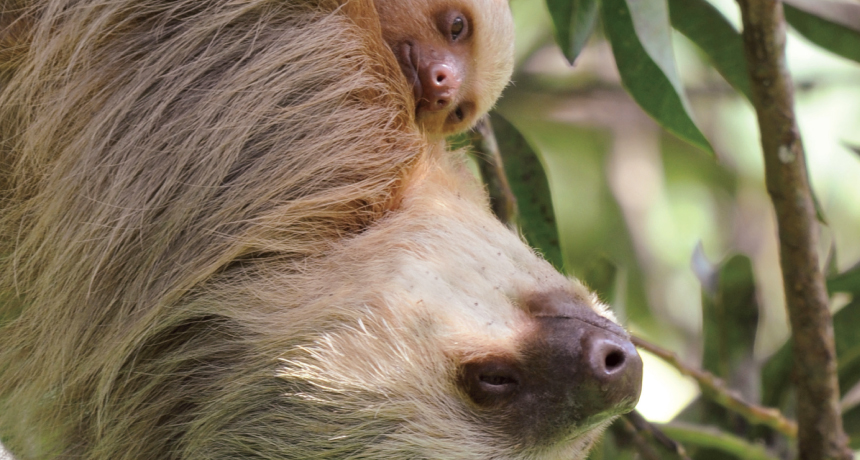For upside-down sloths, what goes down can’t come up

JUST HANG ON A baby three-fingered sloth has to cling tight to mom. Baby sloths are born among the branches and can grip and clamber right away.
worldswildlifewonders/Shutterstock
A sloth can’t vomit. It has a one-way throat, handy for eating while dangling upside down by the toes. But the animal has to be careful not to poison itself by nibbling too many toxic leaves that it can’t easily purge.
There are upsides and downsides to evolving a body that can hang toes-up for some four to six hours a day, as the three-fingered sloth does, says sloth biologist Rebecca Cliffe of the Sloth Sanctuary of Costa Rica near Limón.
She calls her sloths “three-fingered” instead of the more common “three-toed” because all sloths, even so-called two-toed species, actually have three toes on their hind legs. It’s the digits of the front limbs, the fingers, that number either two or three.
One reason both two- and three-fingered sloths have ended up up-ended is that it helps them carry out their fastidious grooming for several hours a day. “They like to scratch with both hands,” Cliffe says.
Three-fingered sloths practice an extreme slothful vegetarianism that can call for topsy-turvy dining. Their digestive systems can’t cope with much fruit or root material, so they snag tender new leaves, sometimes easier to reach from an upside-down perch. Those new leaves may be less likely to deploy a full arsenal of plant-defense toxins that the vomitless sloths can’t get rid of, Cliffe says.
Eating upside down is one thing, but breathing is another. Gravity can pull heavy organs down onto the diaphragm. A brown-throated sloth’s gut (Bradypus variegatus), for instance, can store up to a third of the animal’s body weight in wastes before the weekly (or so) bathroom trip to the forest floor. The gut and other heavy organs are held in place by a web of membranes and internal adhesions, Cliffe and her colleagues report in the April Biology Letters. Breathing easier saves up to 8.6 percent of a sloth’s notoriously tight daily energy budget.
Exploring sloth organs during necropsies, Cliffe and the sanctuary staff at first thought the bits of webbing and adhesions were caused by old injuries. But the “scar tissues” kept turning up in the same places, such as connecting the liver and stomach to the rib cage.
Now Cliffe and her colleagues are looking at the sloths’ upside-down circulatory systems. They don’t know yet, she says, why blood doesn’t rush to a sloth’s upside-down head.
Researcher Rebecca Cliffe of the Sloth Sanctuary of Costa Rica answers questions about sloth biology. Credit: Meet the Sloths/YouTube





